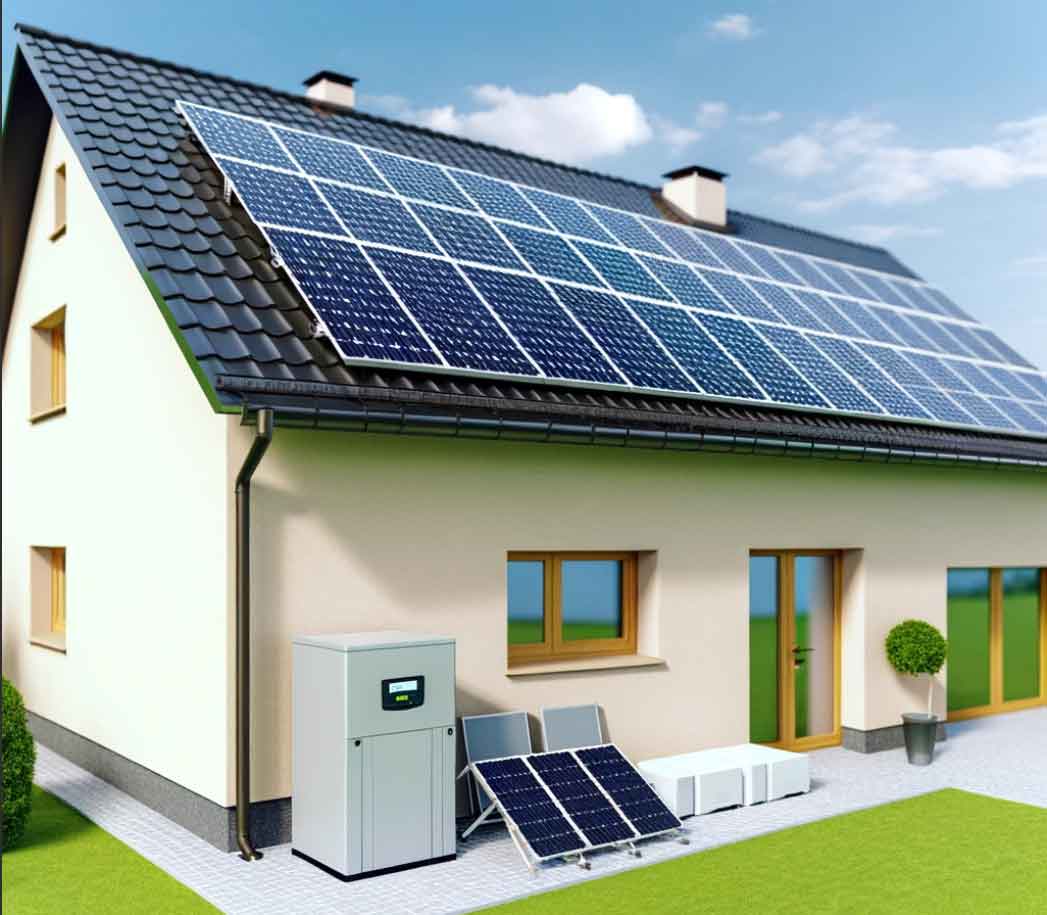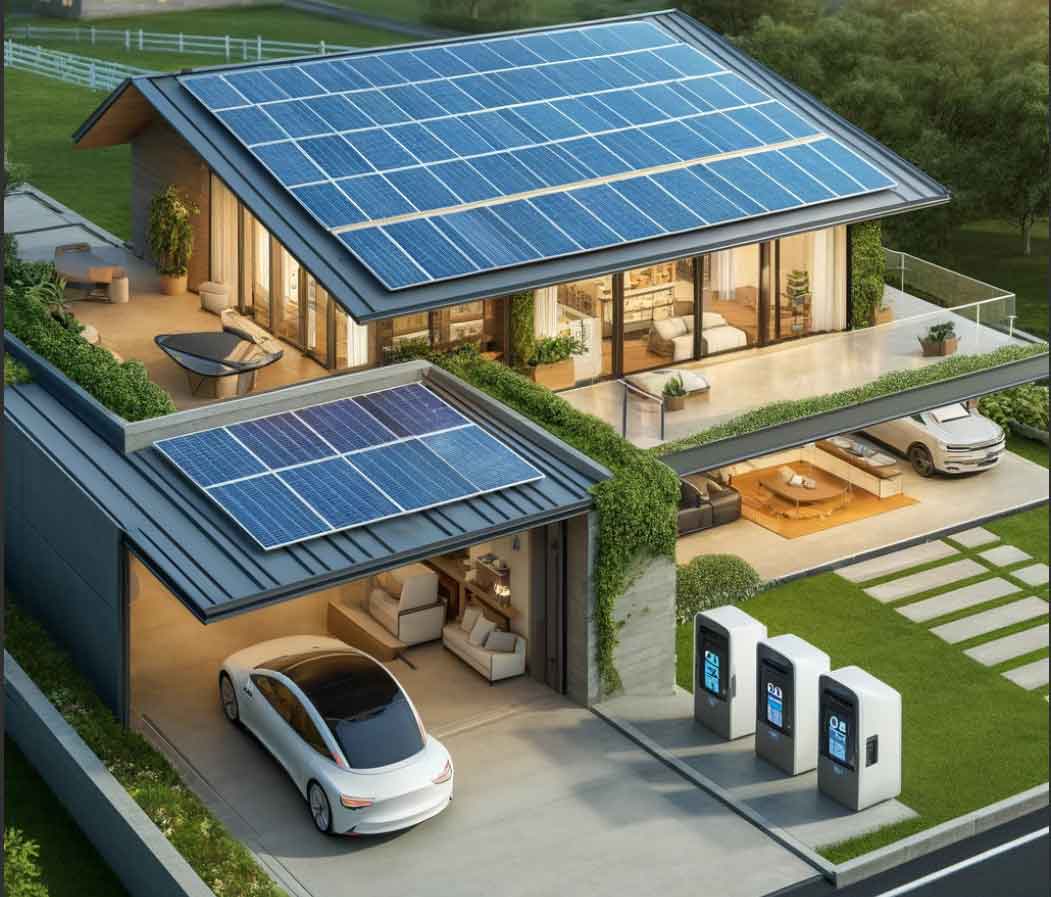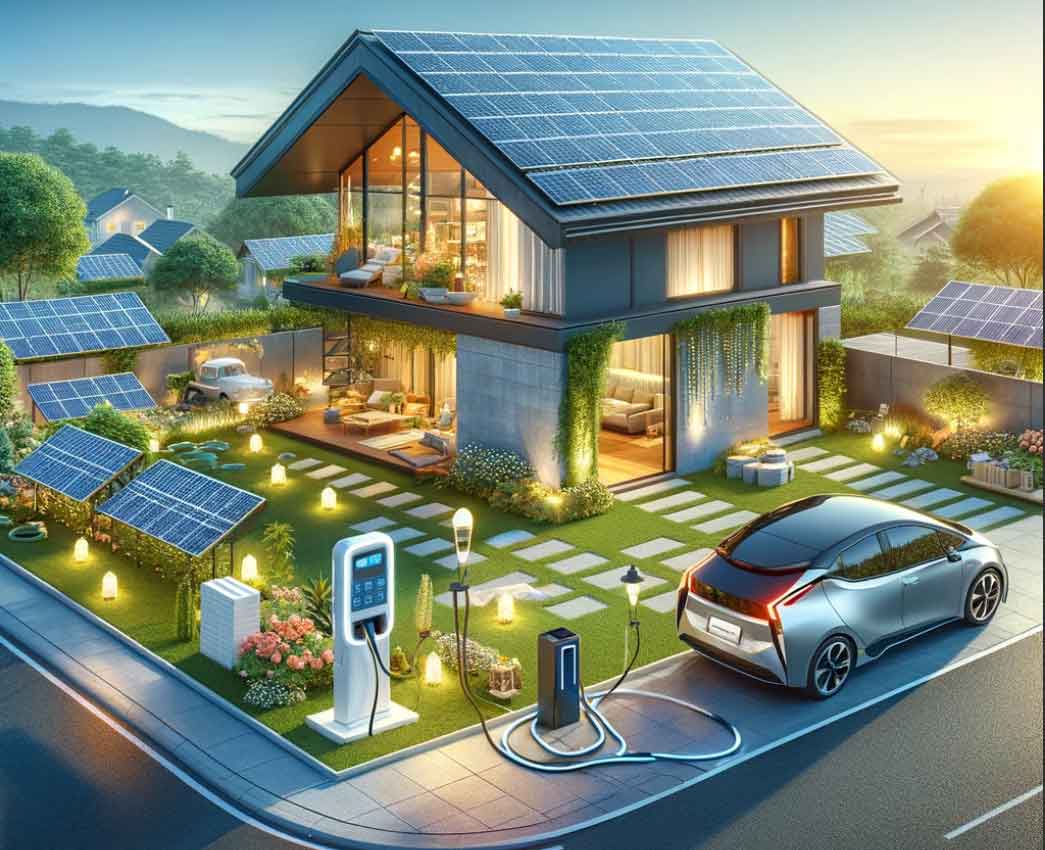Chapter 1: Innovative Designs for Home Solar System

Innovative designs for home solar system is focused on improving efficiency, aesthetic integration, and functionality. Here are some key trends and innovations:
- Building-Integrated Photovoltaics (BIPV): These systems are integrated into the building structure, such as solar shingles or tiles that replace traditional roofing materials. They offer a more aesthetically pleasing and less obtrusive way to incorporate home solar system.
- Transparent Solar Panels: These panels, which can be used as windows or skylights, allow light to pass through while generating electricity. They are ideal for urban environments where space is limited.
- Solar Battery Storage Integration: Modern home solar system often include battery storage, allowing homeowners to store excess energy generated during the day for use at night or during power outages. Innovations in battery technology are making these systems more efficient and affordable.
- Smart Solar Systems: Integration with home automation systems and smart grids allows for more efficient energy management. Homeowners can monitor and control their energy usage in real-time, optimizing their home solar system.
- Flexible and Portable Solar Panels: These panels can be installed in various locations around the house, including curved surfaces. home portable solar system solutions are also gaining popularity for their versatility and ease of use.
- High-Efficiency Panels: Continued advancements in photovoltaic technology have led to panels with higher efficiency rates, meaning more energy can be generated from a smaller area.
- Community Solar Gardens: For homes where installing individual Portable isn’t feasible, community home solar system allow multiple individuals to invest in a shared solar installation, benefiting from the energy produced.
- Solar-Powered Smart Appliances: Integrating home solar system directly into smart home appliances can further optimize energy usage.
These innovations not only enhance the functionality of home solar system but also contribute to their wider acceptance and use in residential settings. As technology advances, we can expect to see even more creative and efficient solutions for home solar system.
Chapter 2: How Home Solar System Changing Energy Consumption
The integration of home solar system is significantly transforming energy consumption patterns in several key ways:
- Reduction in Traditional Energy Use: Homes with home solar system rely less on traditional power grids. This reduces the overall consumption of energy generated from non-renewable sources like coal and natural gas.
- Decentralization of Energy Production: home solar system decentralize energy production. Instead of relying on large, centralized power plants, energy is generated where it is used, which can reduce transmission losses and the need for large-scale infrastructure.
- Energy Independence: Homeowners with home solar system can enjoy a degree of energy independence, reducing their vulnerability to power outages and fluctuating energy prices.
- Net Metering and Energy Sharing: In many regions, homes with home solar system can send excess energy back to the grid through net metering, effectively reducing their energy bills or even earning credits. This also helps in balancing the grid, especially during peak production times.
- Reduced Carbon Footprint: Solar energy is a clean, renewable resource. By using home solar system, homes reduce their carbon footprint, contributing to a decrease in greenhouse gas emissions associated with traditional energy production.
- Encouragement of Energy Efficiency: The adoption of home solar system often comes with increased awareness and efforts towards energy efficiency within the home. Homeowners may invest in energy-efficient appliances, LED lighting, and better insulation, further reducing energy consumption.
- Technological Advancements and Integration: As home solar system technology advances, we are seeing more efficient and affordable panels, as well as the integration of home solar system with other technologies like battery storage systems and smart home devices, enhancing the overall efficiency and management of home energy consumption.
- Grid Stability and Reduced Strain: Widespread adoption of home home solar system can reduce the overall strain on the electrical grid, especially during peak usage hours, and help in maintaining grid stability.
- Shift in Energy Market Dynamics: The rise in home solar system installations is changing the dynamics of the energy market, with utilities having to adapt to a model where they are not just energy providers but also energy purchasers from consumers.
- Potential for Community Solar Projects: For homes that cannot have their own solar installations, community home solar system offer a way to participate in renewable energy efforts. This promotes a collective approach to energy consumption and production.
In summary, the growing adoption of home solar system is promoting a more sustainable, efficient, and decentralized approach to energy consumption, with significant environmental, economic, and social benefits.
Chapter 3: Installing and Maintaining Home Solar System
Installing and maintaining home solar system involves several key steps and considerations. Here’s a comprehensive guide to help you through the process:

Installation Steps
- Assess Your Home’s Suitability for Solar:
- Evaluate your energy needs and determine if your home structure is conducive to home solar system.
- Check factors like roof shading, orientation, angle towards the sun, and roof age.
- Conduct an Energy Audit:
- This helps to understand your current energy consumption and to size your home solar system accordingly.
- Research Incentives and Rebates:
- Look into federal, state, and local incentives, such as the Federal Investment Tax Credit (ITC), which can reduce installation costs.
- Select the Right Solar Panel System:
- Choose from grid-tied, off-grid, or hybrid systems based on your needs and location.
- Size your system appropriately, considering your energy consumption and available space.
- Find a Reputable Installer:
- Compare quotes and choose a qualified home solar system professional to handle the installation.
- Handle Permits and Documentation:
- Your installer should assist with necessary paperwork like incentive applications and building permits.
- Order Equipment:
- The key components include home solar system, inverters, mounting equipment, and wiring.
- Install the Panels:
- Ensure safety measures are followed during the installation of panels on the roof or ground.
- Connect to the Grid (if applicable):
- Work with your utility company and installer to connect your system to the grid.
- Test and Commission the System:
- Check the system’s functionality and monitor its performance for optimal operation.
Maintenance Guidelines
- Routine Cleaning:
- Clean your home solar system 2-4 times per year to remove dirt and debris.
- Use a soft-bristled brush and non-abrasive cleaner, and perform cleaning early in the morning.
- Monitoring System Health:
- Use home solar system monitoring system to track energy production and identify issues.
- Dealing with Snow and Extreme Weather:
- Remove snow using lukewarm water or a squeegee, and avoid using hot water.
- Home solar system are designed to withstand various weather conditions including wind, rain, and hail.
- Annual Professional Inspections:
- Schedule periodic inspections to address any technical issues and extend the lifespan of your system.
- Managing Panel Efficiency:
- In high temperatures, ensure adequate air circulation around the panels to maintain efficiency.
- Repairs and Replacements:
- Contact your installer for any needed repairs or replacements, especially if the panels are under warranty.
Remember, home solar system maintenance is relatively straightforward. Regular cleaning and periodic professional checks are usually sufficient to keep your system in good working condition. For more detailed information, you can refer to EnergySage and SolarReviews.
Chapter 4: Transforming Residential Energy with Home Solar System
Transforming residential energy through home solar system is an impactful and increasingly popular way to make homes more sustainable and energy-efficient. The integration of solar power in residences offers several key benefits and signifies a shift towards greener living. Here’s an overview of how home solar system is revolutionizing residential energy:
1. Reduction in Energy Costs
- Lower Electricity Bills: Home solar system generate free power from the sun, significantly reducing or even eliminating electricity bills. Over time, the savings can be substantial.
- Net Metering: In many regions, homeowners can sell excess home solar system back to the grid, further offsetting costs.
2. Increased Energy Independence
- Reduced Grid Dependence: By generating their own electricity, homeowners become less reliant on utility companies and more self-sufficient.
- Stability Against Power Outages: Home solar system, especially those with battery storage, can provide power during grid outages, ensuring a continuous energy supply.
3. Environmental Benefits
- Reduced Carbon Footprint: Home solar system is clean and renewable, greatly reducing greenhouse gas emissions compared to traditional fossil fuels.
- Sustainable Energy Source: Utilizing home solar system contributes to a sustainable future, reducing reliance on non-renewable energy sources.
4. Enhanced Property Value
- Increased Home Value: Homes equipped with home solar system often have a higher market value and may sell faster than non-solar homes.
5. Technological Advancements
- Innovative Solar Technologies: Advances in home solar system technology have made panels more efficient, affordable, and aesthetically pleasing. Options like solar shingles and transparent home solar system integrate seamlessly with home architecture.
6. Government Incentives and Rebates
- Financial Incentives: Many governments offer tax credits, rebates, and other incentives to encourage the adoption of home solar system, making it more accessible.
7. Community Impact
- Local Energy Production: Home solar system contribute to local energy production, reducing the load on the grid and promoting community resilience.
8. Long-Term Reliability and Low Maintenance
- Durability: Modern home solar system is designed to last for decades, requiring minimal maintenance over their lifespan.
9. Customizable Solutions
- Flexibility in Design: Home solar system can be tailored to individual energy needs and property characteristics, offering versatile solutions for various housing types.
10. Global Trend and Awareness
- Growing Popularity: The global shift towards renewable energy sources has led to increased awareness and adoption of home solar system in residential areas.
Transforming residential energy with home solar system represents a combination of economic, environmental, and technological advancements, marking a significant step towards a more sustainable and independent future in energy consumption.
Chapter 5: The Benefits of Installing a Home Solar System
Installing a home solar system comes with a multitude of benefits, ranging from financial savings to positive environmental impacts. Here are some key advantages:

1. Reduction in Electricity Bills
- Cost Savings: Home solar system generate electricity, reducing the need to buy power from the grid. Over time, these savings can be significant, potentially even eliminating your electricity bill.
2. Environmental Impact
- Clean, Renewable Energy: Home solar system is a green, renewable energy source that reduces reliance on fossil fuels and lowers carbon emissions, contributing to a healthier environment.
3. Energy Independence
- Reduced Dependence on the Grid: Generating your own energy can make you less dependent on utility companies and less affected by power outages or energy price fluctuations.
4. Increase in Property Value
- Higher Home Value: Homes equipped with home solar system have been shown to have higher property values and often sell faster than homes without solar
5. Access to Incentives and Rebates
- Government Incentives: Many governments offer tax credits, rebates, and other financial incentives to encourage the installation of home solar system, making them more affordable.
6. Low Maintenance Requirements
- Ease of Maintenance: Home solar system generally require minimal maintenance, mainly periodic cleaning and inspections, ensuring they remain efficient over their lifespan.
7. Technological Advancements
- Improved Technology: Ongoing technological advancements in solar power improve efficiency and integration, offering diverse options like solar shingles and transparent home solar system.
8. Sustainable Future
- Contribution to Sustainability: By using home solar system, you contribute to a more sustainable and responsible energy future.
9. Long-Term Reliability
- Durability and Longevity: Modern home solar system is designed to be durable and can last for decades, providing a long-term energy solution.
10. Potential for Energy Production Surplus
- Excess Energy Production: In some cases, home solar system produce more electricity than the household can use, allowing homeowners to sell excess energy back to the grid.
Installing a home solar system is not just a financial investment but also a commitment to a more sustainable lifestyle. With advances in technology and supportive policies, home solar system is increasingly becoming an attractive option for homeowners.
Chapter 6: Advancements in Home Solar System Technology
The field of home solar system technology is experiencing rapid advancements, leading to more efficient, cost-effective, and versatile solar solutions. Some of the key developments include:
- Perovskite Solar Cells: Combining perovskites with traditional silicon has led to home solar system that are both more efficient and less expensive to produce. These tandem cells have achieved over 33% efficiency in labs, which is a significant improvement over the current average.
- Flexible and Lightweight Panels: Innovations like thin-film home solar system offer flexibility and lighter weight, making them easier to install and suitable for a variety of surfaces that may not support traditional panels.
- Improved Energy Storage: Advances in battery technology, including lithium-ion and solid-state batteries, allow for more efficient storage of solar energy, enhancing the reliability and usability of home solar system, especially for off-grid applications.
- Smart Solar Systems: Integration with smart home technology and IoT devices enables more effective monitoring and management of energy production and usage, optimizing solar efficiency.
- Building-Integrated Photovoltaics (BIPV): Home solar system technology is being incorporated into building materials like solar shingles, windows, and facades, allowing for seamless integration into the design and architecture of homes.
- Higher Efficiency Panels: Continuous improvements in panel efficiency mean that modern home solar system can convert more sunlight into electricity, even in less-than-ideal lighting conditions.
- Transparent Solar Panels: Development of transparent home solar system opens up new possibilities for integrating solar energy generation into windows and other transparent surfaces without compromising aesthetics.
- Artificial Intelligence and Machine Learning: AI is being used to optimize energy production and predict maintenance needs, enhancing the overall efficiency and lifespan of home solar system.
These advancements are making home solar system more accessible, efficient, and adaptable to various needs and environments, promoting wider adoption of solar technology in residential settings.
Chapter 7: Exploring the Potential of Home Solar System
Exploring the potential of home solar system unveils a wide range of benefits and possibilities for homeowners and the broader energy landscape. The key aspects of this potential include:
Economic Advantages
- Reduced Utility Bills: Homeowners can experience significant savings on their electricity bills, as home solar system generate free energy from the sun .
- Increased Property Value: Home solar system installations can increase the value of a property, making it more attractive to potential buyers.
- Access to Incentives: Many regions offer tax incentives, rebates, and other benefits to homeowners who install home solar system, reducing the initial investment cost.
Environmental Impact
- Reduction of Carbon Footprint: Home solar system is a clean, renewable source that reduces reliance on fossil fuels, leading to lower greenhouse gas emissions.
- Sustainable Energy Source: Home solar system contribute to sustainable energy production, an important factor in combating climate change.
Technological Growth
- Rapid Advancements: Ongoing developments in solar technology, such as higher efficiency panels and advanced energy storage solutions, continually enhance the viability and effectiveness of home solar system.
- Integration with Smart Home Technology: Advances in IoT and smart home technology allow for more effective monitoring and energy management, optimizing the use of home solar system.
Energy Independence
- Reduced Grid Dependence: Generating your own electricity with home solar system means less reliance on the power grid and more control over your energy use.
- Resilience to Power Outages: With energy storage solutions, home solar system can provide electricity during grid outages, enhancing energy security for homeowners.
Scalability and Versatility
- Customization to Needs: Home solar system can be scaled and designed to meet the specific energy requirements and roof space of each home.
- Broad Application: From urban settings to remote areas, home solar system is versatile and can be installed in diverse environments.
Future Potential
- Growing Market: With increasing awareness of renewable energy benefits, the demand for home solar system is expected to grow, further driving innovation and affordability in the sector.
In conclusion, the potential of home solar system is vast, offering numerous benefits that extend beyond individual homes to the broader energy and environmental landscape. This potential is continually enhanced by technological advancements, economic incentives, and a growing global commitment to sustainability.
